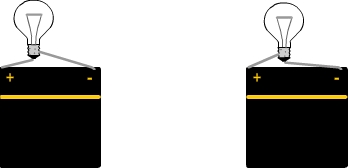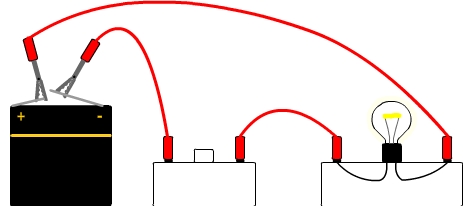
Electricity
Learning physics
and chemistry
easily and freely - Science for elementary school, middle school and
high school
Free online electricity lessons for elementary school, middle school and high school.
How to build simple circuits and draw diagrams
Basic electrical circuit including a bulb
1) Lighting a bulb using only a flat battery
A bulb can be lit if it is traversed by the electric current produced by the battery.
There are two possibilities:

A bulb can be lit if its two terminals are in contact with battery's terminals.
2) Lighting a bulb without direct contact with a flat battery
If the bulb can not receive electric current through direct contact, it can be transmitted through connection wires.
The connection between connection wires and the flat battery requires alligator clips. Furthermore the bulb must be placed on a support.

In a circuit, the current can be transmitted to the different electrical components through the connection wires.
3) Using a switch for controlling the lighting of a bulb
For controlling the lighting of a bulb, that is to say being able to to decide its functioning, we add a switch.
The switch is inserted on the path of electric current in order to interrupt it or allow its circulation.

When the bulb shines it indicates that the switch allows current to flow: The current then follows a path corresponding to a closed loop and for this reason we say that the switch and the circuit are closed.
If the lamp doesn't shine it indicates that the switch interrupts the current flow: The switch opens the loop formed by electrical components and for this reason we say that the switch and the circuit are open.

| Science class |
Chemistry Electricity Optics Mechanics |
| Electricity lessons |
| Electrical
components -Two-terminal electronic components - Basic electrical components - Diodes - What's a resistor ? - How to determine a resistor value ? - Resistors effects in circuits - How to use a resistor ? - Characteristic curve of a resistor How to build simple circuits and draw diagrams - How to build a basic electrical circuit - How to draw diagrams of electric circuits The electric current - Conductors and insulators - Direction of electric current in a circuit - The dangers of electricity - Current intensity - units how to measure current ? The Voltage - The voltage and its units - How to measure a voltage ? - Voltage in open and closed circuits - Rated current and voltage for a lamp Alternating voltage and current - Alternating currents effects on led - What are alternating current and voltage ? - Periodic alternating voltage and its properties - Oscilloscope - Oscillogram - Frequency - Measuring RMS voltage with a voltmeter Serie circuits - What's a serie circuit ? - Series circuit properties - Short circuit in series circuit - Current law in series - circuits - Voltage law in series circuits Parallel circuits - What's a parallel circuit ? - Some parallel circuits properties - Short circuits in parallel circuits - Nodes and branches in parallel circuits - Current laws in parallel circuits - Voltage laws in parallel circuits Laws of electricity - Ohm's law - Current laws in series circuits - Voltage laws in series circuits - Current laws in parallel circuits - Voltage laws in parallel circuits Generating electricity - Voltage for coil wires What is an alternator ? - Alternating currents and voltages - Generating electricity in power plants Electric power and energy - Electric power and power rating - Electric power received by an electrical device - Electric power consumption by an electrical device - Relationship between - Electric power and energy |
|
|
©2021 Physics and chemistry


